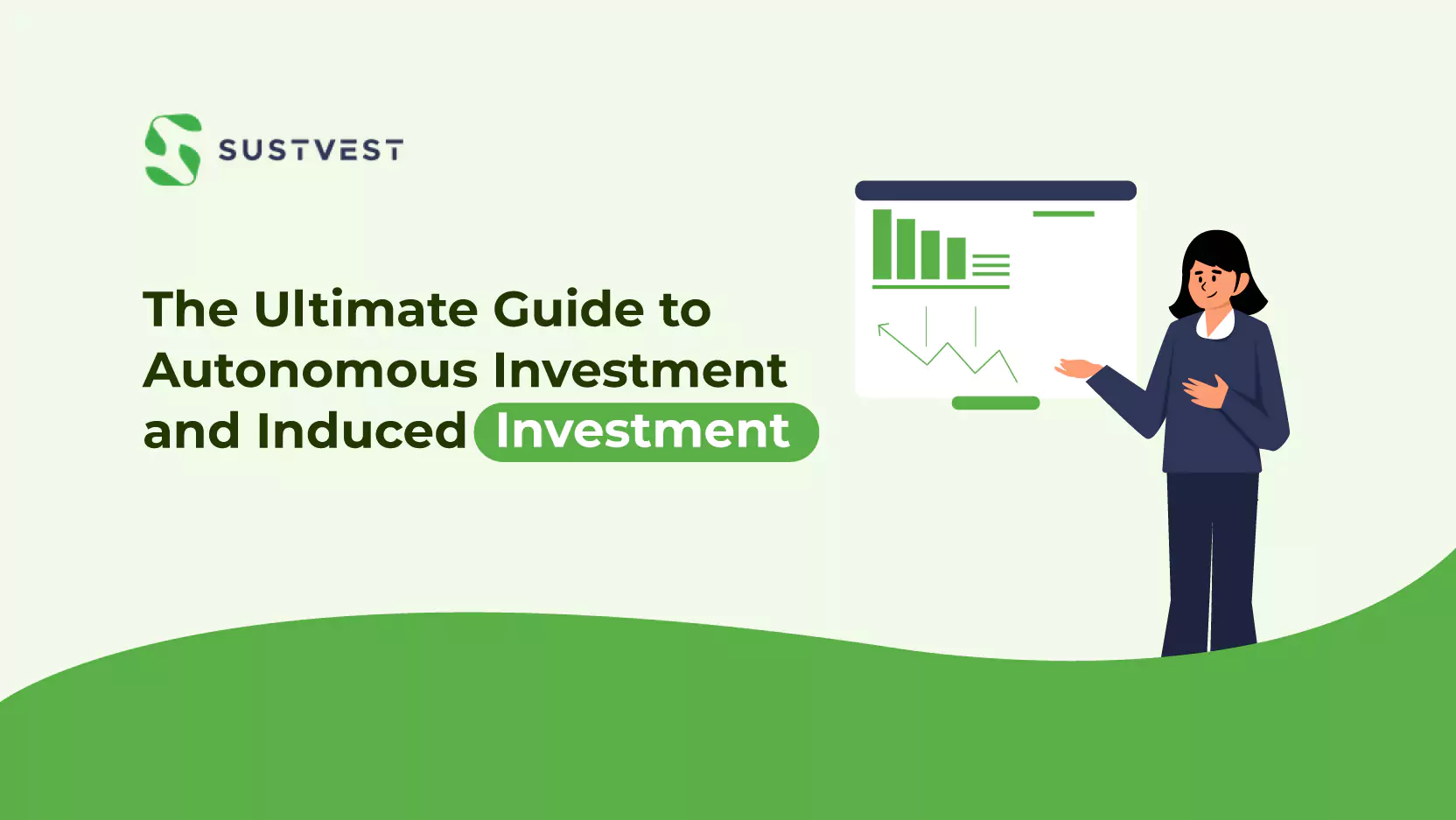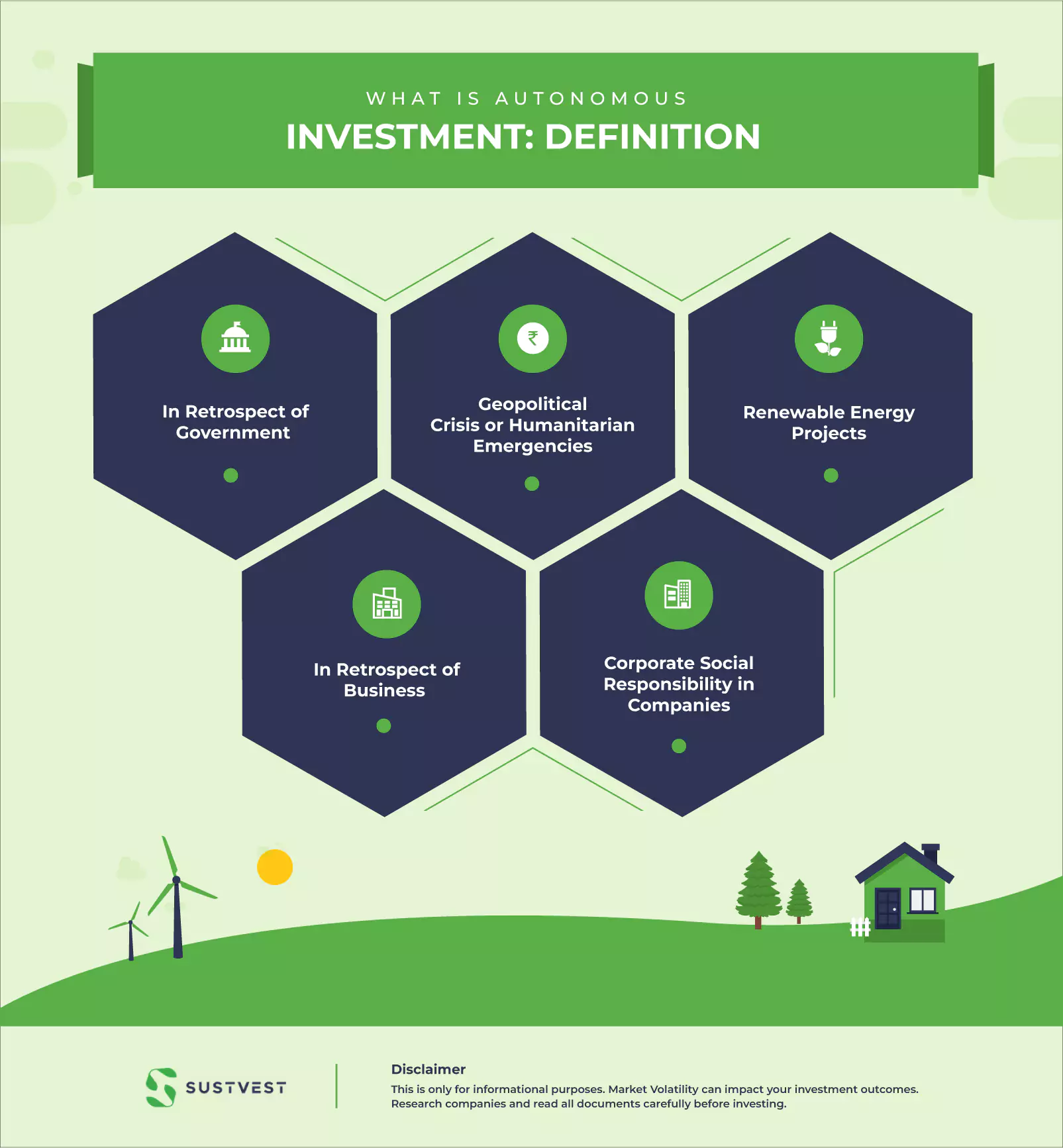In today’s fast-paced investing world, where the allure of quick returns often takes centre stage. The concept of investment often revolves around the pursuit of increased future financial value.
But is there more to investing than mere financial gain? Let’s delve into two distinct types of investment that can shape the future in diverse ways.
Welcome to this insightful blog, where we’ll explore the realms and difference between Autonomous Investment and Induced Investment, understanding the difference between autonomous and induced investment and how they apply to governments, businesses, and retail investors alike.
Before diving deeper, let’s address the fundamental definitions of autonomous and induced investing.

What is Autonomous Investment: Definition
Autonomous investment refers to strategic investments made by institutions, whether governments or businesses, that are not dependent on earning interest, profit, or immediate returns.
Instead of seeking such financial gains, the motive behind autonomous investment is to promote the well-being of the people and society.
In Retrospect of Government
Let’s delve into concrete examples from a government’s perspective to further solidify the autonomous investment concept.
For example, when governments build essential infrastructure like railways or metros, they aim to provide convenience and ease of transportation to the public, thereby improving their quality of life irrespective of whether they profit.
Geopolitical Crisis or Humanitarian Emergencies
A country may deploy its naval forces or invest heavily in its military to protect and support civilians in need. Such actions are autonomous investments to secure citizens’ well-being and safeguard national interests.
Renewable Energy Projects
An organisation or government invests in renewable energy projects like solar or wind farms. These investments are autonomous as they promote sustainable energy sources, reduce reliance on fossil fuels, and contribute to environmental conservation.
In Retrospect of Business
In the business realm, autonomous investments can be observed in various initiatives. For instance, companies may invest in employee training or software upgrades to enhance operational efficiency and productivity. These investments are driven by the goal of long-term growth and competitiveness, with managers focusing on strategic advantages rather than immediate financial gains.
Corporate Social Responsibility in Companies
Another striking example of where companies invest in the wellness of others and society is when they carry out CSR. Corporate Social Responsibility is a practice where companies voluntarily take on initiatives and projects that contribute to the well-being of others and society.
These were a few examples of how autonomous investment works. To better understand the difference between autonomous and induced investment, knowing what Induced Investment consists of is imminent.

What is Induced Investment?
Induced investment refers to investments motivated by the goal of making financial gains, such as earning higher interest rates, profits, or income. In simple terms, it’s about investing money to make more money.
Induced Investment From Business Perspective
From a business perspective, induced investment can be witnessed with a company’s profit increased marginally and gradually.
As the business grows, the manager starts investing to double, triple, and quadruple those profits. Thus, machinery sometimes replaces the workforce solely to cut costs and increase profit. This way, a company expands vertically and horizontally, diversifying and reaching new markets or product lines.
The level of induced investment is directly tied to the company’s ability to generate profits. The company can afford to make more investments for future growth when profits are high. But during tough times, businesses may reduce their investment activities to focus on recovering their initial assets.
In a nutshell, induced investment is about using profits wisely to fuel further growth and profitability. It differs from other types of investments, like autonomous investment, which may have other motives beyond just financial gain.
What Is the Difference Between Autonomous and Induced Investment?
The comparison chart below clearly describes the difference between autonomous and induced investment.
| The Difference | Autonomous Investment | Induced Investment |
| Influence of Investing Decision | The decision to make an Autonomous Investment is not influenced by factors such as income, profit, or returns. | The decision to make an Induced investment is directly influenced by the future prospects of profit, income, and return. |
| Relation with income | Autonomous Investments are not related to income. Regardless of the level of incomes, these investments are certain. | Induced investments have a direct relation with income. As income grows, the investment also increases accordingly. |
| Goal | The goal of Autonomous Investment is the well-being of society and people. | The goal of Induced Investment is to multiply profits. |
| Who does it? | Generally Autonomous Investments are carried out by the government and related public institutions with the primary goal of promoting the welfare of people and society. | Induced Investments are typically carried out by businesses with the primary objective of increasing profits and maximising financial returns. |
| Time Horizon | Autonomous investments are typically considered as long-term goals that require skillful planning and strategic thinking. | Short-term goals driven by the desire to maximise profits |
| How Do They Respond to Changes? | Autonomous Investments are Unaffected by changes in income, demand , supply and profit and rate of interest. | Induced investments are directly affected by income, demand, supply, profit and rate of interest. |
| Source of Investment | Sources of autonomous investment are mostly carried by the government thus is derived from public tax. | Induced Investments are sourced from the previous profits or increased income. |
| Examples | If we see Indian government initiatives like Clean Mission India, Make in India, Renewable Energy Investments, Smart Cities Mission are considered as Autonomous Investments. | Some of the Induced Investment examples are FDI, Public Private Partnership, UPI and Digital Investments. |
Autonomous and Induced Investment for Retail Investors
Once you grasp the clear difference between autonomous and induced investment, the next step is to learn its importance and relevance from different perspectives. Let’s explore their significance from various angles.
Induced Investment: From Retail Investment Perspective
Retail investors are focused on earning maximum returns from their investments, which is an instinct when investing hard-earned money. Such assets can help build a secure future, combat inflation, and provide a financial blanket for retirement. This approach can be related to induced investment, where the primary focus is prioritising financial gains.
The Consequences of a One-Sided Investment Strategy
The decades of relentless pursuit of profits have resulted in a world where organic and natural products are more expensive than their harmful pesticide-laden alternatives. The irony of this situation further threatens our survival.
Therefore, an action must be taken to protect the environment. As a response, investors have begun to realise their role in promoting sustainable practices and contributing to the welfare of society – a concept that can be related to autonomous investment.
Bridging The Difference Between Autonomous And Induced Investment
What if there were a way to bridge the difference between autonomous and induced investment? Investors can still pursue financial gains, but now their investments can also be directed toward society and the planet’s well-being. This approach integrates both motives, creating a win-win scenario for financial growth and positive societal impact.
Meeting In the Middle: Where the Difference Between Induced And Autonomous Investment Creates A Balance Approach
In the past decade, governments and international organisations have recognized the difference between autonomous and induced investment and addressed them by introducing newer concepts like ESG, SRI, and Impact investing.
ESG Investing
E – Environment: This aspect encourages investment in companies that prioritize environment-friendly practices in their day-to-day operations. These practices may include reducing single-use plastics as packaging materials and adopting eco-friendly waste disposal methods.
S – Social: The Social factor encourages investment in companies that prioritize employee-friendly work practices and focus on the betterment of their customers and other stakeholders.
G – Governance: The Governance aspect encourages investment in companies that comply with government rules and regulations, practise ethical business methods, and uphold transparency and integrity in their operations.
Thus, ESG investing encourages investing in companies with high ESG scores based on diverse parameters aligned with Environmental, Social, and Governance (ESG) factors..
Socially Responsible Investment (SRI)
SRI employs a screening method, with negative screening excluding companies from investment based on the absence of sustainable practices. These companies pose a threat to a healthy and functional society. Examples of such industries are the gambling industry, tobacco industry, and liquor industry.
On the other hand, positive screening in SRI focuses on companies that excel in their ESG scores and actively work towards adopting green practices in business. For example, having a water conservation policy, investing in energy-efficient machinery, and implementing environment-friendly work policies.
Impact Investing
Impact investing involves investing in companies or industries that work toward social and environmental change. For example, investing in companies that prioritise sustainable packaging, source materials using renewable energy, or support social causes, such as hiring specially-abled people in their workforce.
Impact investing aims to create positive outcomes for society and the planet while seeking financial returns.
Whether it’s ESG, SRI, or Impact Investing, they balance the mindset of solely making an investment of deriving profits and doing good so that sustainability in business and the environment thrive.
The Bottom Line
As a retail investor, choosing between autonomous and induced investments is paramount. Induced investments lead you toward financial prosperity, enabling you to build a solid financial foundation for the future.
However, overlooking autonomous investments can have long-term repercussions, affecting access to a healthy lifestyle with clean air, fresh produce, and a sustainable environment. To strike the right chord, prioritise investments in ESG, SRI, or Impact investing strategies.
Consider Sustvest, for instance—an opportunity to earn monthly passive income with as low as 15000 INR, representing the induced part of your investment. Simultaneously, investing in solar energy projects ensures a thriving society and planet, emphasising the autonomous aspect of your investment.
Remember that embracing autonomous and induced investment strategies is not just about numbers and profits. It’s about positively impacting the world with Sustvest while securing your financial well-being.

Founder of Sustvest
Hardik completed his B.Tech from BITS Pilani. Keeping the current global scenario, the growth of renewable energy in mind, and people looking for investment opportunities in mind he founded SustVest ( formerly, Solar Grid X ) in 2018. This venture led him to achieve the ‘Emerging Fintech Talent of the Year in MENA region ‘ in October 2019.




